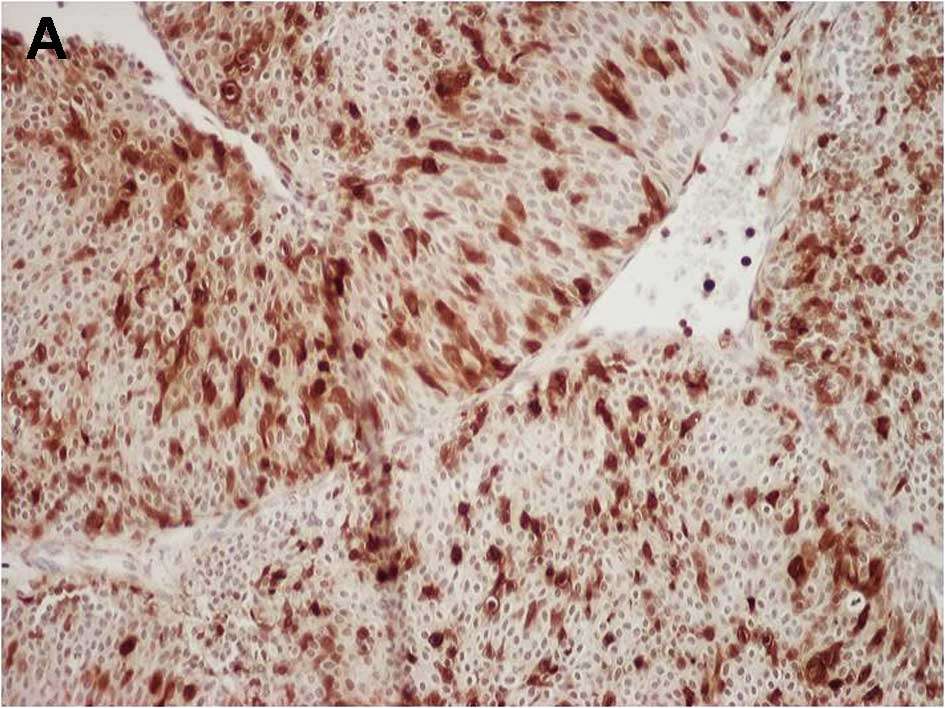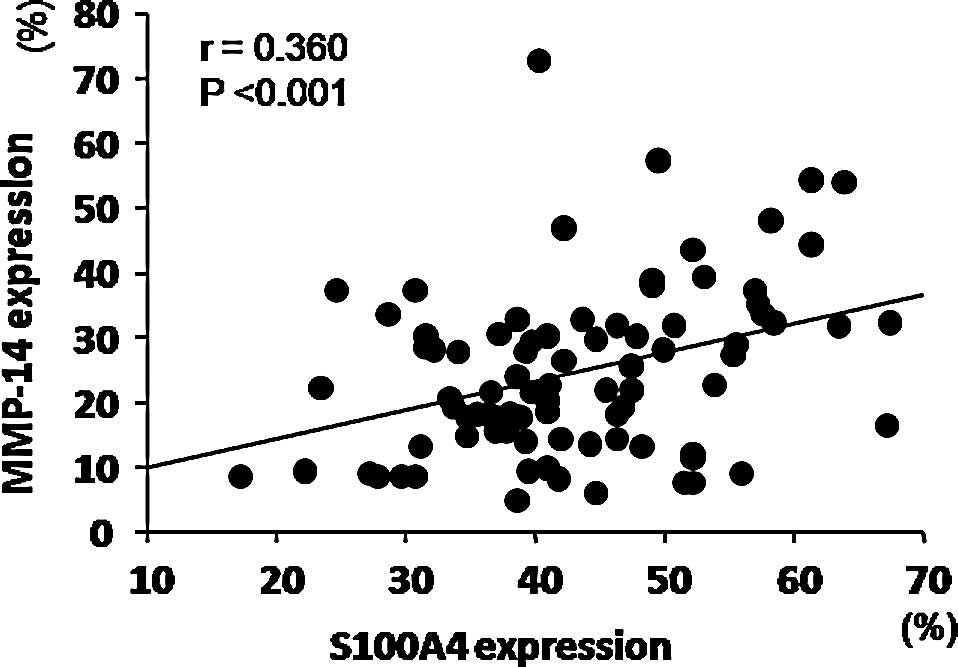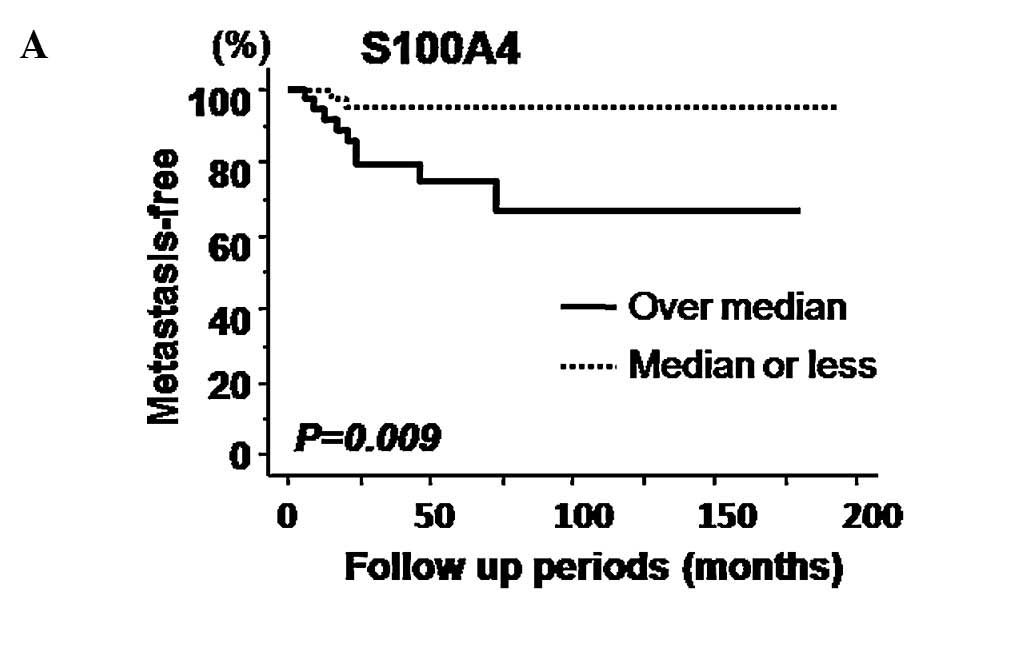|
1.
|
Heizmann CW, Fritz G and Schafer BW: S100
proteins: structure, functions and pathology. Front Biosci.
7:d1356–d1368. 2002.
|
|
2.
|
Ebralidze A, Tulcinsky E, Grigorian M,
Afanasyeva A, Senin V, Revazova E and Lukanidin E: Isolation and
characterization of a gene specifically expressed in different
metastatic cells and whose deduced gene product has a high degree
of homology to a Ca2+-binding protein family. Genes Dev.
3:1086–1093. 1989.
|
|
3.
|
Yao R, Davidson DD, Lopez-Beltran A,
MacLennan GT, Montironi R and Cheng L: The S100 proteins for
screening and prognostic grading of bladder cancer. Histol
Histopathol. 22:1025–1032. 2007.
|
|
4.
|
Matsumoto K, Irie A, Satoh T, Ishii J,
Iwabuchi K, Iwamura M, Egawa S and Baba S: Expression of S100A2 and
S100A4 predicts for disease progression and patient survival in
bladder cancer. Urology. 70:602–607. 2007.
|
|
5.
|
Jemal A, Siegel R, Ward E, Hao Y, Xu J,
Murray T and Thun MJ: Cancer statistics, 2008. CA Cancer J Clin.
58:71–96. 2007.
|
|
6.
|
Heney NM, Ahmed S, Flanagan MJ, Frable W,
Corder MP, Haffermann MD and Hawkins IR: Superficial bladder
cancer: progression and recurrence. J Urol. 130:1083–1086.
1983.
|
|
7.
|
Sternberg S, Donat J, Bellmunt R, Millikan
W, Stadler P, De Mulder A, Sherif H, von der Maase T, Tsukamoto M
and Soloway M: Chemotherapy for bladder cancer: treatment
guidelines for neoadjuvant chemotherapy and metastatic cancer.
Urology. 69:62–79. 2007.
|
|
8.
|
Bellmunt J, Albiol S and Kataja V; EMSO
Guidelines Working Group: Invasive bladder cancer: ESMO clinical
recommendations for diagnosis, treatment and follow-up. Ann Oncol.
19(Suppl 2): 47–48. 2008.
|
|
9.
|
Garrett SC, Varney KM, Weber DJ and
Bresnick AR: S100A4, a mediator of metastasis. J Biol Chem.
281:677–680. 2006.
|
|
10.
|
Deryugina EI and Quigley JP: Matrix
metalloproteinases and tumor metastasis. Cancer Metastasis Rev.
25:9–34. 2006.
|
|
11.
|
Bjørnland K, Winberg JO, Odegaard OT,
Hoving E, Loennechen T, Aasen AO, Fodstad O and Maelandsmo GM:
S100A4 involvement in metastasis: degradation of matrix
metalloproteinases and tissues inhibitors of matrix
metalloproteinases in osteosarcoma cells transfected with an
anti-S100A4 ribozyme. Cancer Res. 59:4702–4708. 1999.
|
|
12.
|
Mathisen B, Lindstad RI, Hansen J,
El-Gewely SA, Maelandsmo GM, Hoving E, Fodstad O, Loennechen T and
Winberg JO: S100A4 regulates membrane induced activation of matrix
metalloproteinase-2 in osteosarcoma cells. Clin Exp Metastasis.
20:701–711. 2003.
|
|
13.
|
Saleem M, Kweon M-H, Johnson JJ, Adhami
MA, Elcheva A, Khan N, Hataluri V and Mukhtar H: S100A4 accelerates
tumorigenesis and invasion of human prostate cancer through the
transcriptional regulation of matrix metalloproteinase 9. Proc Natl
Acad Sci USA. 103:14825–14830. 2006.
|
|
14.
|
Gontero P, Banisadr S, Frea B and Brausi
M: Metastasis markers in bladder cancer; a review of literature and
clinical considerations. Eur Urol. 46:296–311. 2004.
|
|
15.
|
Kanayama H, Yokota K, Kurokawa Y, Murakami
Y, Nishitani M and Kagawa S: Prognostic values of matrix
metalloproteinase-2 and tissue inhibitor of matrix
metalloproteinase-2 expression in bladder cancer. Cancer.
82:1359–1366. 1998.
|
|
16.
|
Furukawa A, Tsuji M, Nishitani T, Kanda K,
Inoue Y, Knayama H and Kagawa S: Role of the matrix
metalloproteinase and tissue inhibitors of metalloproteinase
families in noninvasive and invasive tumors transplanted in mice
with severe combined immunodeficiency. Urology. 51:849–853.
1998.
|
|
17.
|
Hara I, Miyake H, Hara S, Arakawa S and
Kamidono S: Significance of matrix metalloproteinase and tissue
inhibitors of metalloproteinase expression in the recurrence of
superficial transitional cell carcinoma of the bladder. J Urol.
165:1769–1772. 2001.
|
|
18.
|
Wallard MJ, Pennington CJ,
Veerakumarasivam A, Burtt G, Mills IG, Warren A, Leung HY, Murphy
G, Edwards DR, Neal DE and Kelly JD: Comprehensive profiling and
localization of the matrix metalloproteinases in urothelial
carcinoma. Br J Cancer. 94:569–757. 2006.
|
|
19.
|
Ismail NI, Kaur G, Hashim H and Hassan MS:
S100A4 overexpression proves to be independent marker for breast
cancer progression. Cancer Cell Int. 5:8–12. 2008.
|
|
20.
|
Maruta S, Sakai H, Kanda S, Hayashi T,
Kanetake H and Miyata Y: E1AF expression is associated with
extra-prostatic growth and matrix metalloproteinase-7 expression in
prostate cancer. APMIS. 117:791–796. 2009.
|
|
21.
|
Davies BR, O’Donnell M, Durkan GC, Rudland
PS, Barraclough R, Neal DE and Mellon JK: Expression of S100A4
protein is associated with metastasis and reduced survival in human
bladder cancer. J Pathol. 196:292–299. 2002.
|
|
22.
|
DeLassus GS, Cho H, Park J and Eliceiri
GL: New pathway links from cancer-progression determinants to gene
expression of matrix metalloproteinases in breast cancer cells. J
Cell Physiol. 217:739–744. 2008.
|
|
23.
|
Agerbaek M, Alsner J, Marcussen N,
Lundbeck F and von der Maase H: Focal S100A4 protein expression is
an independent predictor of development of metastatic disease in
cystectomized bladder cancer patients. Eur Urol. 50:777–785.
2006.
|













